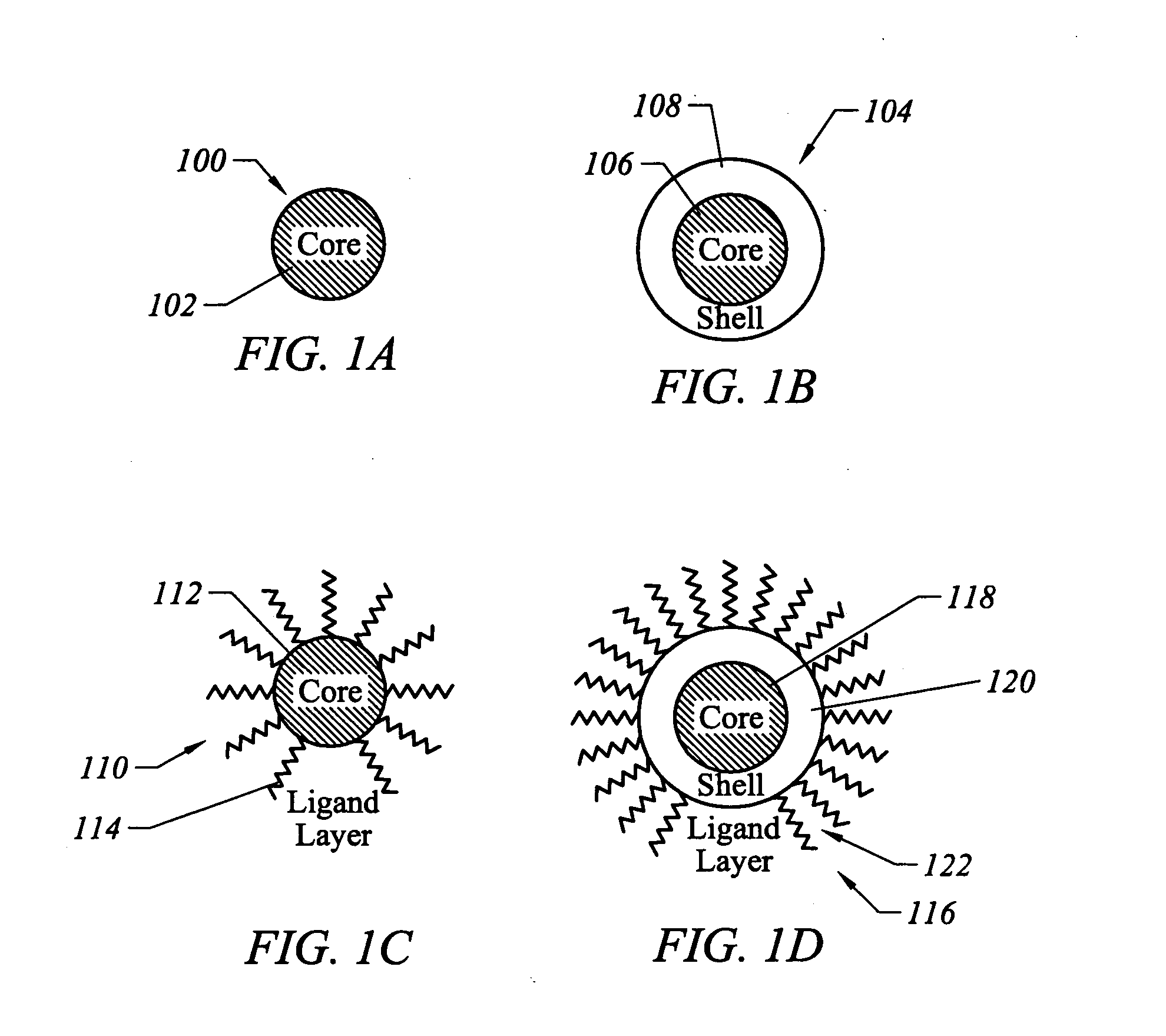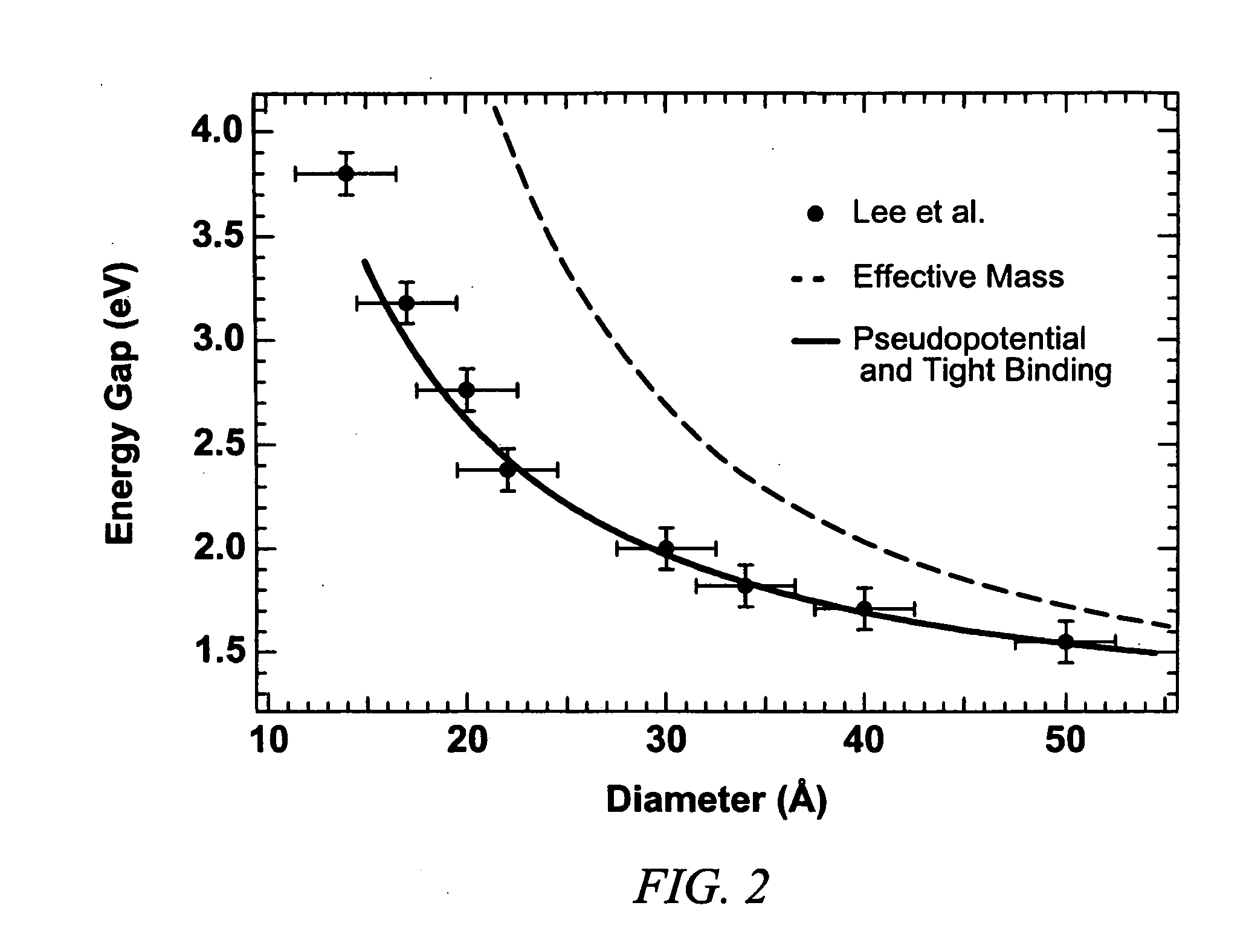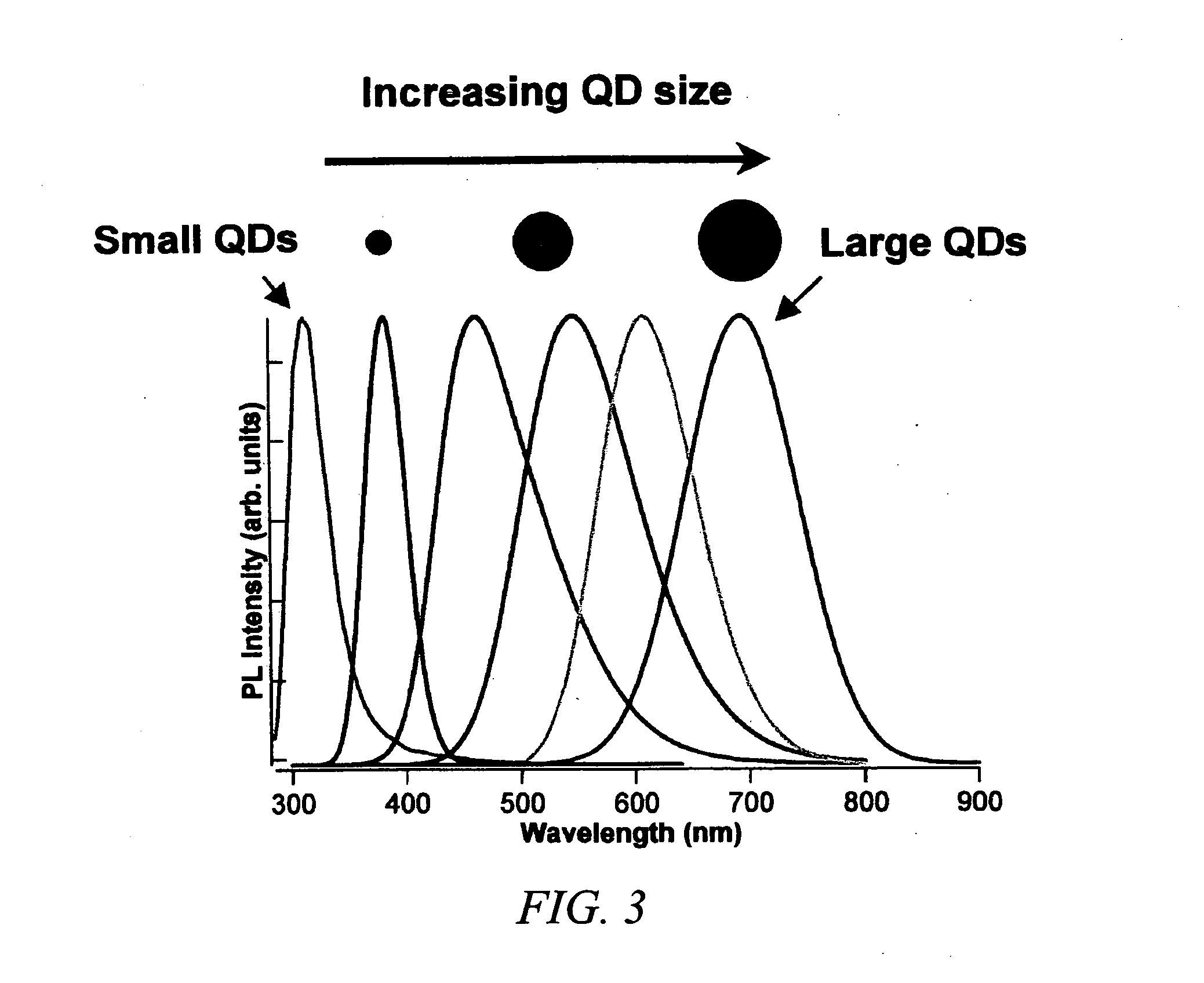Optical devices with engineered nonlinear nanocomposite materials
Inactive Publication Date: 2005-03-17
SAMSUNG ELECTRONICS CO LTD
View PDF0 Cites 46 Cited by
- Summary
- Abstract
- Description
- Claims
- Application Information
AI Technical Summary
Benefits of technology
Resonant processes typically result from a change in electronic properties upon resonant excitation (e.g., the linear absorption of light). This leads to a corresponding change in refractive index, following the Kramers-Kroenig relations. The magnitude of an absorption change, and hence the optical nonlinearity, is directly related to the ground state absorption cross-section modified by any excited state absorption. In the case of a material with discrete states, such as molecules or quantum dots, the optical nonlinearity results from state-filling and is related to (σg−σe), where σg and σe are the absorption cross sections of the material in the ground and excited states respectively, with a reduction in refractive index occurring for a reduction in absorption. For quantum dots, further enhancement of χ(3) results from unique physical phenomena such as quantum confinement, local electric field effects, and quantum interference effects.
As indicated above, the optical nonlinearity is related to (σg−σe), so that increasing the oscillator strength of optical transitions from the ground state generally increases the optical nonlinearity. In the case of quantum dots, a decrease in size increases the spatial overlap of the electron and hole wave functions, which in turn increases the oscillator strength. Resonant nonlinearity therefore tends to increase with decreasing size. This enhancement, however, can be limited by any size dispersion.
Another important effect arises from the presence of one or more defects in a quantum dot. Defects can be present as trap states within the quantum dot. Due to the enormous surface to volume ratio in the size range of quantum dots, most relevant traps exist on the surface. If not passivated correctly, resonant excitation of a quantum dot creates electron-hole pairs that quickly relax into these surface-states. Holes, with their relatively large effective mass, tend to trap more easily, while the electrons, with their smaller effective mass, remain largely delocalized. The result is a spatial separation of the electron and hole wavefunctions and a decrease in oscillator strength, reducing the magnitude of the resulting nonlinearity. Furthermore, by tailoring the rate of relaxat
Problems solved by technology
Most current optical cross-connect systems comprise high-speed electronic cores, which are complex, cumbersome, and expensive.
The complexity, size, and expense of such optical-to-electronic-to-optical (OEO) components become even more problematic with higher bit-rates and port counts, even as the cost of electronic components decreases, due to cross-talk and RF transport issues.
OEO devices are typically the rate-limiting component in an optical network.
Many all-optical switching technologies are relatively slow and are therefore generally limited to static configuration control.
These relatively slow all-optical switches, however, are generally inadequate for fast switching applications such as dynamic packet switching (˜1 ns), optical modulation (˜100 ps), header reading in packet switched networks (<25 ps), and all-optical data-processing (<1 ps).
However, these devices are rapidly approaching their speed limits, as they rely on fast electronic signals in order to perform optical processing or modulation, and these electronic signals suffer increasingly greater losses due to the fundamental limitations of high-speed electrical propagation.
Of these nonlinear optical phenomena, χ(3) based phenomena have the most flexibility but currently suffer from a lack of practical materials with both high nonlinearity and relatively low loss.
Due to the small γ of silica, however, impractical fiber lengths (˜1000 km) are required for these devices to operate at typical telecommunication powers (˜10 mW).
While this technology is extremely advanced in the field of microelectronics, it is still in its infancy with respect to optics.
For instance, for χ(2) based devices, crystalline LiNiO3 cannot be arbitrarily inserted within a waveguide created by these techniques.
In addition, polymeric nonlinear materials, which are more easily processed, typically have values for χ(3) that are too low for efficient switching.
While proof-of-concept for all-optical switches based on SOAs has been shown, problems with amplified spontaneous emission buildup currently make cascading many of these switches problematic.
In addition, the materials used for SOAs (typically InP) are expensive and create inherent difficulties with coupling to standard silica fibers and waveguides.
Photonic bandgap materials are another promising approach, but manufacturing using the previously proposed materials is still beyond current practical capabilities.
Finally, new nonlinear crystalline materials have been developed (e.g. periodically poled LiNbO3 and p-toluene sulphonate (PTS)) but are typically expensive and difficult to process, making incorporation into waveguide devices problematic.
Nonlinear polymers, with more appealing mechanical properties, have also been developed, but problems such as kinks in the polymer chains can limit the maximum nonlinearity to a value still unsuitable for practical all-optical applications.
In cases where highly nonlinear polymers have been produced (e.g., polyacetylene), many of the appealing mechanical properties are lost, creating problems similar to those found in crystalline materials.
As such, it has been extremely difficult to find a practical material that simultaneously satisfies various requirements for a commercial χ(3) based nonlinear device.
While many materials may have one or more of these desirable characteristics, at present, no single material comprises a sufficient number of these characteristics required for an optimal χ(3) based optical switch.
In fact, besides SOAs, no commercial devices are currently available, primarily due to a lack of appropriate nonlinear optical materials.
Method used
the structure of the environmentally friendly knitted fabric provided by the present invention; figure 2 Flow chart of the yarn wrapping machine for environmentally friendly knitted fabrics and storage devices; image 3 Is the parameter map of the yarn covering machine
View moreImage
Smart Image Click on the blue labels to locate them in the text.
Smart ImageViewing Examples
Examples
Experimental program
Comparison scheme
Effect test
example 8
The preparation of Example 1 is repeated using 3-butenylmagnesium bromide as the capping agent.
example 9
The preparation of Example 1 is repeated using allylmagnesium bromide as the capping agent.
example 10
The preparation of Example 1 is repeated using 4-methoxyphenylithium as the capping agent.
the structure of the environmentally friendly knitted fabric provided by the present invention; figure 2 Flow chart of the yarn wrapping machine for environmentally friendly knitted fabrics and storage devices; image 3 Is the parameter map of the yarn covering machine
Login to View More PUM
 Login to View More
Login to View More Abstract
The invention relates to an optical device. The optical device comprises a waveguide core and a nanocomposite material optically coupled to the waveguide core. The nanocomposite material includes a plurality of quantum dots. The nanocomposite material has a nonlinear index of refraction γ that is at least 10−9 cm2 / W when irradiated with an activation light having a wavelength λ between approximately 3×10−5 cm and 2×10−4 cm.
Description
FIELD OF THE INVENTION This invention relates generally to optical devices. More particularly, this invention relates to optical devices comprising engineered nonlinear nanocomposite materials. BACKGROUND OF THE INVENTION As telecommunication networks continue to expand their need for bandwidth, it is becoming increasingly necessary to introduce new technologies to keep up with growing demands. These technologies should not only facilitate the need for bandwidth but also be easily incorporated into today's network infrastructure. At the same time, they should be flexible and versatile enough to fit the requirements of the future. While current telecommunication systems comprise a combination of electronic and optical data-transmission, there is pressure to move towards all-optical networks due to the increased bandwidth provided by high bit-rates and parallel transmission through wavelength division multiplexing. Currently, optical networks use light for much of the transmission ...
Claims
the structure of the environmentally friendly knitted fabric provided by the present invention; figure 2 Flow chart of the yarn wrapping machine for environmentally friendly knitted fabrics and storage devices; image 3 Is the parameter map of the yarn covering machine
Login to View More Application Information
Patent Timeline
 Login to View More
Login to View More IPC IPC(8): G02B6/12G02B6/122G02F1/017G02F1/35G02F1/355G02F1/365G02F2/00H01L21/20H01L29/12H01L29/16H01L33/20H01L33/34
CPCB82Y10/00Y10S977/834C25F3/12G02B6/122G02B6/1225G02B6/356G02B2006/12097G02B2006/12145G02B2006/12147G02B2006/12159G02B2006/12195G02F1/3515G02F1/3517G02F1/3521G02F1/3556G02F1/365G02F2001/01791G02F2001/217G02F2002/006G02F2202/32G02F2202/36H01L29/127H01L29/16H01L29/1602H01L33/20H01L33/34B82Y20/00G02F1/01791G02F1/217G02F2/006
Inventor LEE, HOWARD WING HOONCHIN, ALAN HAPPFENNINGER, WILLIAM MATTHEW
Owner SAMSUNG ELECTRONICS CO LTD
Features
- R&D
- Intellectual Property
- Life Sciences
- Materials
- Tech Scout
Why Patsnap Eureka
- Unparalleled Data Quality
- Higher Quality Content
- 60% Fewer Hallucinations
Social media
Patsnap Eureka Blog
Learn More Browse by: Latest US Patents, China's latest patents, Technical Efficacy Thesaurus, Application Domain, Technology Topic, Popular Technical Reports.
© 2025 PatSnap. All rights reserved.Legal|Privacy policy|Modern Slavery Act Transparency Statement|Sitemap|About US| Contact US: help@patsnap.com



